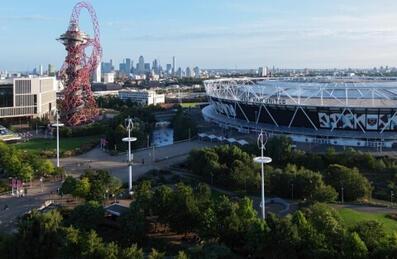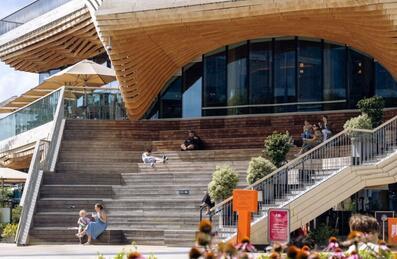
Popular Searches:
Keep up to date
Sign up today for exclusive offers and incredible experiences you won’t want to miss at Queen Elizabeth Olympic Park.
Sign up nowFixed Estate Charge
Following on from the success of the London 2012 Olympic and Paralympic Games, London Legacy Development Corporation was given a once in a lifetime opportunity to develop a new metropolitan heart for east London where people choose to live, work and play.
Statement on the Queen Elizabeth Olympic Park Fixed Estate Charge
The Fixed Estate Charge was developed to contribute towards the cost of maintaining Queen Elizabeth Olympic Park’s parklands and its facilities, as an Estate for the enjoyment of all those living on, working in or visiting the Park. It is a fixed charge, dependent on the nature of the use, index linked and paid to London Legacy Development Corporation, which may be utilised to upkeep and maintain the Park and its Venues, and applies to all types of occupier on Queen Elizabeth Olympic Park estate (Queen Elizabeth Olympic Park estate is outlined in blue on the attached plan and may be subject to variation from time to time).
At the request of the Mayor a review of the Fixed Estate Charge was undertaken by the Deputy Mayor of Planning, Regeneration and Skills, Jules Pipe and published in February 2023. This page also provides information about the review and LLDC’s response to it.
Fixed Estate Charge Q&A
What is the Fixed Estate Charge and who pays it?
The Fixed Estate Charge contributes to the development and on-going maintenance costs of Queen Elizabeth Olympic Park. The charge applies to commercial and residential occupiers on the Park, as outlined by the LLDC boundary.
How has the charge been calculated?
The Fixed Estate Charge is a contribution and not directly linked to the cost of estate services. The structure of the charge will vary according to the contractual arrangements in place across different zones of the Park. The value of the charge will vary in accordance with permitted use for each property (ie commercial, community or residential). The Fixed Estate Charge rates are set out in the legal paperwork linked to each property. In order to understand the basis of each charge you will need to contact the organisation that invoices you, e.g. Chobham Manor LLP.
What is the Fixed Estate Charge spent on?
The Fixed Estate Charge contributes towards the management of the parklands, footpaths, cycle ways, bridges,waterways and venues that make up Queen Elizabeth Olympic Park.
- Maintenance of hard and soft landscaping and planting in the Park
- Provision and maintenance of safety equipment
- Provision and maintenance of lights, street furniture and other amenities
- Provision of security and CCTV
- Provision of pest control services
What is the difference between the Fixed Estate Charge and Council Tax?
In 2016, the Mayor of London delegated responsibility to LLDC for the maintenance and upkeep of the Park to a standard that would secure its regeneration and development. The Fixed Estate Charge is the levy charged by the London Legacy Development Corporation to pay for that maintenance. Council Tax on the other hand is a tax charged by local authorities in Britain, based on the estimated value of a property and the number of people living in it. The Council Tax is collected directly by the local authority and is used to fund the cost of services like refuse collection, highway maintenance and schools.
Why are residents and non-residents treated the same in terms of discounts for venues even though residents pay the FEC?
The Fixed Estate Charge is not linked to any residential discount schemes. The Mayor directed LLDC to make the charge in recognition of our obligation to maintain the Park and Venues to an appropriate standard.
Why aren’t East Village and Glasshouse Gardens residents in the zone, yet Chobham Manor residents are?
East Village & Glasshouse Gardens fall outside of the Park boundary.
What are the official borders of the Park for the FEC?
Please refer to the map showing the Fixed Estate Charge boundaries on the Park.
If Chobham Manor residents pay the FEC towards the upkeep and maintenance of the Park why are standards completely different between Chobham Manor and the rest of the Park?
While the Fixed Estate Charge is payable by all businesses and residents on the Park certain areas are managed differently. Each of the new neighbourhoods, including Chobham Manor, are managed by the developer who takes responsibility for grass cutting, litter picking etc. The FEC payments go towards the cost of maintaining the other areas of the Park.
How much would residents have to pay if they were interested in buying the freehold of the property?
LLDC does not wish or intend to dispose of the freehold interest in flats and apartments (NB houses on Chobham Manor have already been sold on a freehold basis). However, residents wishing to buy the freehold should seek independent legal advice.
Where can I find the Fixed Estate Charge shown in your Annual Report and Accounts?
Fixed Estate Charge income is included within the Financing and Investment Income in Note 7 of the Annual Report and Accounts. It is also referenced in the Annual Governance Statement.
Below is a link to LLDC’s currently available accounts:
https://www.queenelizabetholympicpark.co.uk/our-story/how-we-work/good-governance/accounts
A report detailing the expenditure on the Park and FEC is published annually. The report for 2022/23 is linked below.
The FEC is not a service charge but a fixed payment. The FEC is shown in the accounts as income and it is not referable or linked to the cost of the estate services.
There is more information on the Fixed Estate Charge on the GLA website.
FEC Review
At the request of the Mayor a review of the Fixed Estate Charge was undertaken by the Deputy Mayor of Planning, Regeneration and Skills, Jules Pipe and published in February 2023 and LLDC’s response is set out below:
Annual Report on FEC for Residents and Commercial Occupiers
Queen Elizabeth Park Fixed Estate Charge Review – LLDC response
LLDC welcomes the Mayor’s review of the Fixed Estate Charge and has accepted all the recommendations made. We are now working to implement them as soon as possible and will ensure that we keep FEC payers, the Mayor and London Assembly up to date with progress.
The FEC Review reflects the success of the legacy of the London 2012 Olympic and Paralympic Games and the importance of Queen Elizabeth Olympic Park as a strategic public asset driving the regeneration of the wider area, transforming the area financially, economically, ecologically and socially. LLDC was pleased to see that the FEC Review underlined the importance of maintaining the long-term financial sustainability of the Park to safeguard and continue the legacy and the conclusion that the payment of the Fixed Estate Charge (FEC) by those who benefit most from the Park - as one part of the funding for the maintenance of the Park - is fair. LLDC also notes that the review looked at benchmarking against other similar schemes and found that FEC rates are broadly comparable with other schemes. LLDC also notes that the FEC Review sets out the legal advice that FEC is not a Ground Rent.
LLDC acknowledges and understands why the Mayor of London asked for the FEC Review to be undertaken and welcomes the considerations for improvements, which have been agreed by the Mayor of London. The FEC Review notes that, due to reasons outside of LLDC’s control, the FEC scheme was not set up in the most equitable way and that it would have been fairer if other residents and institutions near the Park (e.g. East Village and Glasshouse Gardens) were subject to the FEC. LLDC accepts this point but has no means of applying the FEC Charge to these areas, as it does not own the land for these developments. LLDC agrees with the FEC Review that it should therefore seek to make improvements, particularly for those residents paying the FEC.
The FEC Review recommends that Rick Roberts Way - land owned by LLDC, where a new neighbourhood is being planned - should not be part of the FEC boundary due to the physical barrier of Stratford High Street between Rick Roberts Way and the Park, and LLDC accepts this conclusion.
Improvements
LLDC accepts all of the recommendations made by the Mayor of London and will make delivering them a key priority. Responsibility for delivery of each recommendation has been given to a named senior LLDC officer and delivery will be overseen by LLDC’s Executive Director of Park Operations and Venues. LLDC has tight budgets and other priorities, so there will be financial assessments made in considering the means of delivering the recommendations, in consultation with the GLA’s finance team. Regular updates on the delivery of the recommendations are provided to the Mayor of London and LLDC’s Investment Committee, the most recent update in February 2024 can be found here.











